PROTECTING THE DEMOCRATIC VOTE: Part 3
A Formula
for Catching Election Fraud
Michael Collins and TruthIsAll
“Scoop” Independent
News
Washington, DC
Part 1 (10/26) - Part 2 (10/31)
INTRODUCTION
November 7, 2006 promises to be a watershed event in the political history of the United States of America. After six long years of the Bush Administration the public is poised to clean house and throw the bums out. These colloquial phrases represent the fervently held hopes of the 55% to 60% of the people who consistently disapprove of the Bush presidency. However, a darker horizon beckons due to the inevitable temptations to deliver the vote in ways that deny the public will.
Two major reasons for concern about a free and fair election are found in these simple title changes that will occur in a Democratic House of Representatives: Chairman Conyers and Chairman Waxman. The thought of these two experienced, intelligent, and wily legislators in charge of the key House investigative committees must strike terror in the hearts of those who may be subject to investigations. Therefore it is reasonable to assume that what can be done will be done to avoid this horror. It makes perfect sense.
We know that there have been frequent instances of elections gone wrong since 2000. The curious events preceding the surprise losses of Senator Cleland and Governor Barnes in Georgia 2002 were an immediate cause of concern for careful observers. The intense concern just might have had something to do with the software patch applied to one third of that state’s electronic voting machines just before the election. That software patch that was never investigated or even explained even though it occurred right before an election that saw a highly improbable last minute reversal of substantial leads by those two Democrats.
We then witnessed the travesty of 2004 when, at the very least, the state of Ohio was moved from the Democrat to Republican column through an assortment of highly effective voter suppression and ballot alteration tactics. The remainder of the country saw significant anomalies as well. Battle ground state after battle ground state switched to the Republican column throughout the night violating the well established laws of mathematics concerning large sample polling. Of course, everyone paying attention at the time knows that the 2000 election was stolen away from the Florida hot house of political intrigue and handed to the most partisan Supreme Court in US history to do its dirty work.
There is a powerful incentive to alter the results of this election and a recent history of election outrages to justify extreme vigilance. Sadly, only the tiniest fraction of the population would endorse this were there any degree of general awareness. The recent demonstration of voting machine problems at Princeton University that caused such a stir is just a punctuation mark in a much longer history of election fraud that began in earnest with the Compromise of 1876. Black Americans have not voted in higher numbers since Reconstruction which that compromise ended. As we pointed out in the first article of this series, there are many methods of voter suppression and voter disenfranchisement that exist entirely outside the realm of electronic voting. The opportunities for election fraud are multifold.
This is the ultimate comment on the status of the election tomorrow can be found here:
Soaries excoriates both Congress and the White House, referring to their dedication to reforming American election issues as "a charade" and "a travesty," and says the system now in place is " ripe for stealing elections and for fraud."
Rev. DeForest Soaries, appointed by George W. Bush as first Chairman, Election Assistance Commission. Exclusive reporting by Brad Friedman, The BradBlog 10/17/06
Overview
Based on extensive analysis of a broad range of pre-election polls, it appears likely that, absent election fraud, the following will result:
- A Democratic House – 36 to 40 seats change from Republican to Democratic
- A Democratic Senate - 6 seats change from Republican to Democratic
In order to protect the democratic voting process and assure the realization of the will of the people:
- A simple formula is presented to the built in anti-Democrat bias of the current system.
- 27 of 41 best Democratic pick up opportunities are at risk based on this formula.
Once again, we’re poised to live through another of those miraculous last minute comebacks with two minutes to go in the fourth quarter. We’ve heard Rove say his math is right and that of the pollsters is wrong. Just today ABC and PEW released two outlier polls showing a tightening of the generic preference for House control. While these firms may have adopted Rovian math, the other nine national polls conducted at the same time record the same large spread reflecting an overwhelming public preference for Democratic control of Congress.
The basis for a big surprise is already being laid. The vote switching has begun with absentee ballots, and the voters who will be turned away because they’ve been purged (now in all 50 states) have not even had a chance to get upset.
Please vote, regardless of your party affiliation or candidate choice and while you’re dong that, observe locally and read nationally about the calamity that awaits us, election day November 7, 2006.
GENERIC POLLING DATA: The Democrats are consistently favored
The Republicans got their best news since the day Mark Foley went into seclusion. The PEW and ABC polls showed a tightening of the generic public preference congress. This news was treated as revealed truth by the usual suspects: Blitzer, Greenfield, and Larry King. Unfortunately for the spin doctors, the other nine polls conducted about the same time show a 50% preference for Democrats and only 38% for Republicans nationwide.
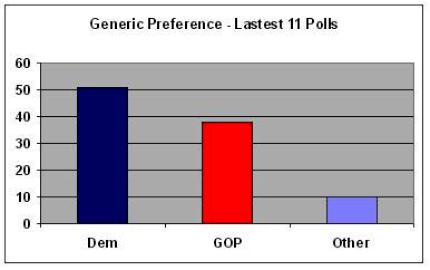
Even with the Pew and ABC polls in the mix, the 11 poll average shows a continuing public preference for the Democrats. We can understand why the Republicans would tout the two anomalous polls but why would CNN offer such uncritical and false endorsements of this claim?
The following analysis shows the latest national average from PollingReport.com. Taking into account the Undecided Voter Allocation (UVA) assumption of 60% for Democratic challengers, the Democratic generic vote should exceed 56% on Election Day.
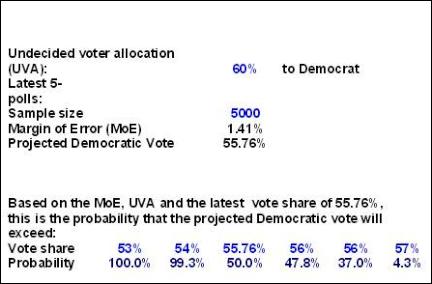
The United States HOUSE OF REPRESENTATIVES
GOP House Seats in Play: 62. Latest polling: 11/05/06.
There are 62 Republican seats with a significant Democratic challenge. This analysis shows that up to 42 seats can move into the Democratic camp. This trend has been in place for months. The likely alternative to a Democratic sweep will come about due to election fraud or election challenges decided by state legislatures or courts. There is a 62% probability that at least 40 seats will turn from Republican to Democrat - presuming no fraud.
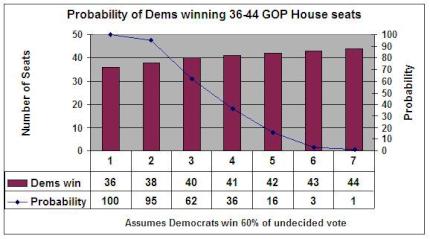
Big Version
There are 62 Republicans with significant Democratic challenger. This analysis shows that up to 40 of those seats can move into the Democratic camp. The environment causing this change has been in place for months. The likely alternative would be election fraud or election challenges decided by state legislatures or courts. Forty seats are gained at a 62% probability.
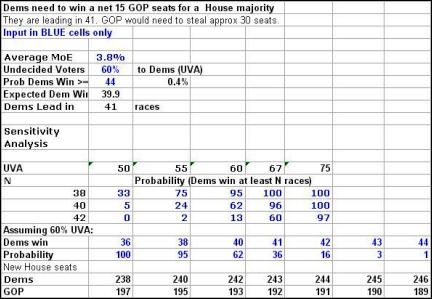
The Democrats lead in 41 races after
applying the undecided voter allocation (UVA).
With 67%
of the undecided voters, Democrats will pick up even more
seats than the 41 leads thus gaining a huge advantage in the
House.
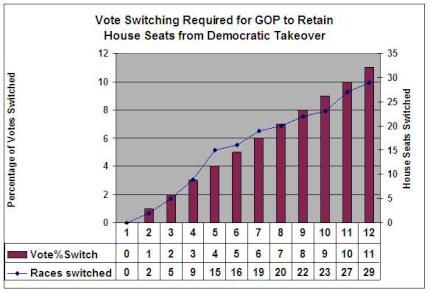
Big Version
Aside from divine
intervention (which is not anticipated at present) the only
path to a Republican Congress is through the application of
election fraud. ¬

How would the fraud work? Each election, the Democrats lose between 2% and 3% of their votes due to spoiled ballots. These spoiled ballots show up most often in minority and poor neighborhoods. Professor Phillip A. Klinkner buried forever the assumption that the poor and minorities cannot master the voting process. His study of Florida voting in 2000, with particular attention to spoiled ballots, is a landmark document on elections in the United States.
The United States SENATE
Control of the United States Senate is a huge prize.
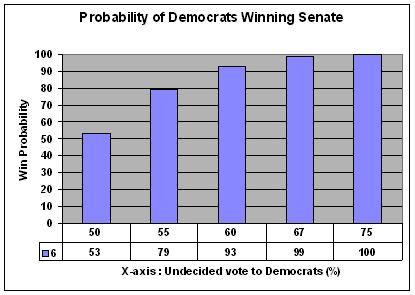
Big Version
Prospects for Senate control look better than they did in our October 31 article. At just 55%of undecided voters picking Democrats, there is a 79% probability that the Senate will change hands.
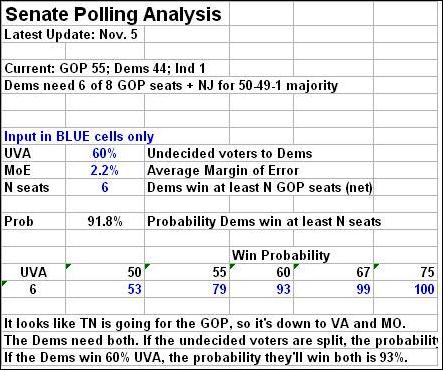
The Democrats need to win six GOP-held seats (net of any Democratic seats lost) up for election. The win probabilities are listed above. Based on the current polling average, if the election was held today, absent election fraud the Democrats have an excellent chance of winning the six seats.
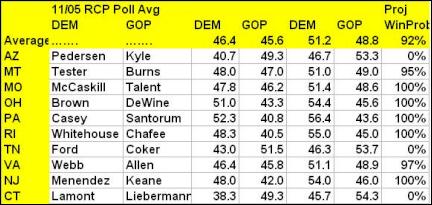
RCP = www.RealClearPolitics.com
Eleven critical Senate races are presented above. The Democrats must win six of the ten GOP seats to regain control of the Senate. Unfortunately, Lamont looks like he will lose (probably due to lack of party support) and the dynamic Ford has fallen in the polls (after his opponent ran racist commercials). Webb has pulled ahead of Allen and McCaskill looks very good now against Talent.
VOTE FRAUD MODEL -
TruthIsAll
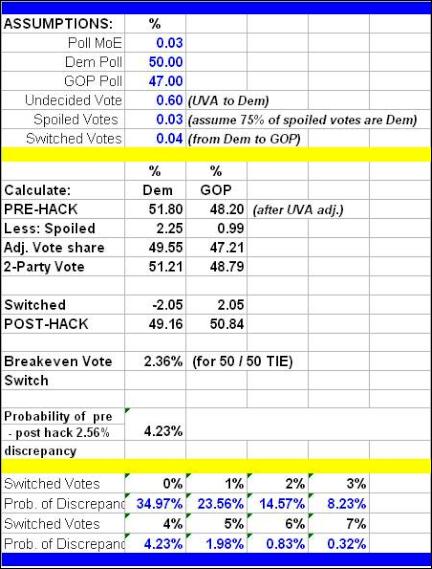
Click for big version
Applying this model to the probable – possible wins by the Democrats against incumbent Republicans (see chart below) 14 likely wins emerge outside of the fraud margin, but 27 seats remain within the Margin of Fraud as defined above. These require careful monitoring and analysis. They are critical targets if the plan unfolds to keep the House at any cost.
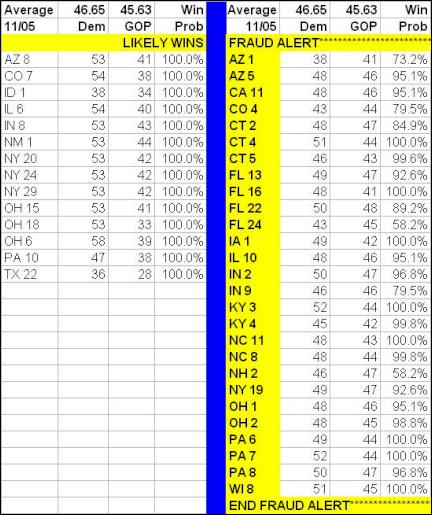
Click for big version
This table represents the races to watch, target for support and monitor post election. Every win on the right side of the blue line is a victory for the Democrats and more importantly for democracy. Holding fair elections isn’t that complicated. As a result, any meltdowns, supply shortages, switched votes, voter intimidation, etc. etc., take place in these districts need to be questioned and examined thoroughly.
What can be done?
This question has been answered already by the absence of action over the past two years. Those concerned about the security and sanctity of our elections were told that voter verified paper ballots were the solution. These purported auxiliary ballots pop out of the touch screen voting machines. They verify only what is printed on them and but not necessarily the votes that have been cast (the computer can record whatever it is programmed to record and print a separate item as a verification). Due to widely varying but almost always restrictive recount laws, they are not likely to be used at any time in the near future to settle the outcome of an election. There are 13 states with both verified paper ballots for touch screen voting machines and a mandates to use them. We should watch closely and see if those original 13 are exempt from the anticipated problems on election day.
We are in an era of inherently unverifiable election results both in actual fact and in the public perception. Thus, any result can be challenged for any number of reasons, most of which cannot be investigated. The computer voting process typically eliminates any ballot record other than that stored on the voting machine. The only evidence of voter intent is recorded in secret in the voting machine which, like any computer, can be programmed to do just about anything with that ballot record.
Given the tentativeness of the election process, we need to bring the best analysis to bear, expose glaring problems, and demand investigations immediately. This article is the final of a three part series on election 2006. Mathematician and prolific internet poster TruthIsAll’s provides a forecast of probable wins for the House and Senate by the Democrats. In addition, he offers a clear method of analyzing election results and provides methods of identifying possible/probably instances of election fraud.
Ask yourself these two questions…
How many election challenges have you seen in your life? How many of those were initiated by the candidates involved?
It is clear that in order to clean up our election system and ensure free and fair elections that include all of those eligible without hindrance; the citizens are the responsible parties for change. The politicians have their own agenda as do the parties. It is up to each of us to make political process work in a way that produces vastly different results. Neglect of the process has given us a President who advocates torture as a national policy, invades nations without any real justification, ignores the environment, and, as his first Elections Assistance Commissioner pointed out, shows no respect for the election process. It is now time for the people to take responsibility for the conduct and outcome of the elections that have such great influence over their lives.
©Copyright: Please feel free to reproduce and
distribute this in any fashion you feel suitable with an
attribution of authorship and the publisher, “Scoop”
Independent News, plus a link to the
article.


 Gordon Campbell: On The Making Of King Donald
Gordon Campbell: On The Making Of King Donald Binoy Kampmark: Rogue States And Thought Crimes - Israel Strikes Iran
Binoy Kampmark: Rogue States And Thought Crimes - Israel Strikes Iran Eugene Doyle: The West’s War On Iran
Eugene Doyle: The West’s War On Iran Richard S. Ehrlich: Deadly Border Feud Between Thailand & Cambodia
Richard S. Ehrlich: Deadly Border Feud Between Thailand & Cambodia Gordon Campbell: On Free Speech And Anti-Semitism
Gordon Campbell: On Free Speech And Anti-Semitism Ian Powell: The Disgrace Of The Hospice Care Funding Scandal
Ian Powell: The Disgrace Of The Hospice Care Funding Scandal